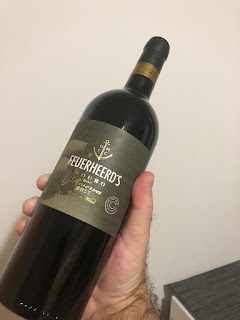 |
| Feuerheerd's 2017 Douro Reserva |
Why wine bottles are generally 750 ml (75 cl) and not one liter (1,000 ml).
Where does this sizing is coming from?
Round figures dominate this world; most of the alcohol bottles are the only ones with a capacity of 750 ml.:
Why is this?
Why does a bottle of wine not contain an entire liter?
Why not settle with half-liter bottles?
The most common wine bottle capacity was normalized in the 19th century, and since then, this bottle sie is now used, not just for the wine, almost for all bottled liquids. There are the craziest explanations for this fact, such as:
The pulmonary capacity of a glassmaker;
The production of glass bottles was an artisan process until it was industrialized in the eighteenth century. During the production process, after heating and liquify the glass, blowing air thru a tube was to create and shape the bottle as we know it. The blowing was continuously, and as a result of the theoretical human lungs capacity we ended up with +/- 70ml bottle capacity. This standardization has been carried out and has proven to be a very successful model since it is using as the perfect amount for an adult couple meal. A curiosity that makes wine an even more special drink.
The average consumption in a meal;
We are speaking of an alcoholic drink, and 750ml is a high amount even when consumed during an entire day.
But others speculate as it is the best capacity to conserve wine, being the easy way of transport (really ??) or being the regular human hand size. It is merely a practical organization with a historical basis and my belief:
 |
Domiziano 2018 1,5L from
Cellino San Marco Italy South
|
At the beginning of the 19th century, the main customers of Portuguese and French wine producers were English. But they never adopted the same European measures units.
The volume unit of the English was the “imperial gallon,” which was precisely 4.54609 liters.
To simplify conversion accounts, they transported the wine in 225-liter barrels, precisely 50 gallons, corresponding to 300 750 ml bottles. (75 centiliters).
 |
| Picture from https://zephyronline.com site |
The calculation is straight easier, they adopted that a kite = 50 gallons = 300 bottles.
In this way, one gallon corresponded to 6 bottles, and the main reason, even today, wine boxes usually have 6 or 12 bottles.
Wine is part of world history and this controversial factoid could be a learning lesson!
Other Wine bottles sizes and their designations:
375 ml Demi or Half: it is the correspondent to one-half of the standard 750 ml bottle size.
750 ml Standard: The traditional wine bottle size for most given wine.
1.5 L Magnum: The equivalent of two standard 750 ml wine bottles.
3.0 L Double Magnum: The equivalent to two Magnums or four standard 750 ml wine bottles.
4.5 L Jeroboam: Equivalent to six standard 750 ml wine bottles.
4.5 L Rehoboam: A sparkling wine bottle with six standard 750 ml wine bottles.
6.0 L Imperial: The equivalent to eight standard 750 ml wine bottles or two Double Magnums.
9.0 L Salmanazar: The equivalent to twelve standard 750 ml wine bottles or a full 12 box of wine.
12.0 L Balthazar: The equivalent to sixteen standard 750 ml wine bottles.
15.0 L Nebuchadnezzar: The equivalent to twenty standard 750 ml wine bottles.
18.0 L Solomon: The equivalent to twenty-four standard 750 ml wine bottles.



Comments
Post a Comment